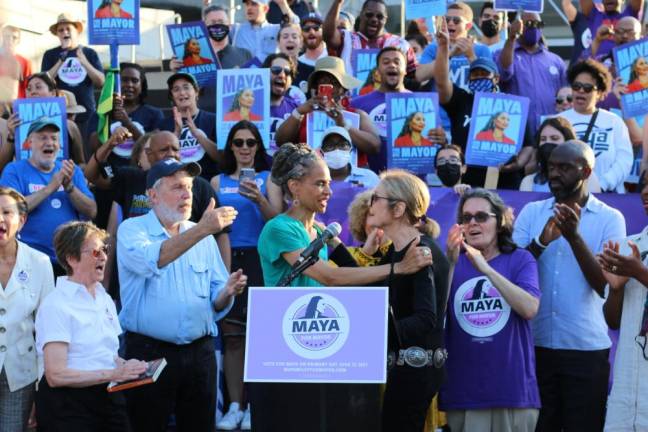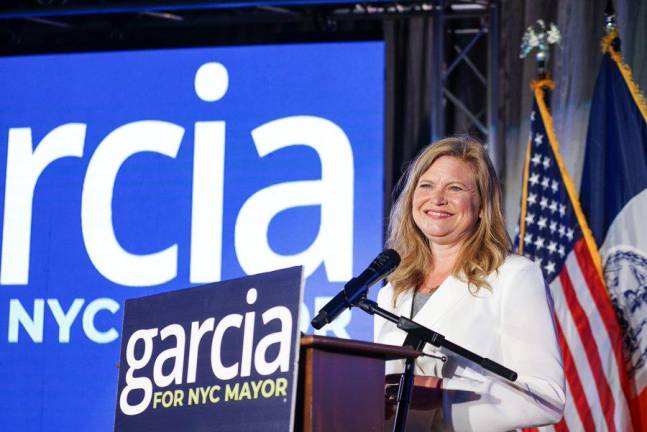Messages, Myths and the Mayoral Race
Tally of first choices in the primary showed that New Yorkers want “an old-school liberal”



New York is a progressive city. Just not that progressive.
That message emerged clearly from the otherwise complicated primary elections results. “The vast majority of New Yorkers want an old-school liberal,” observed Ester Fuchs, a professor at Columbia University and longtime analyst of New York politics.
“There were some myths that were debunked,” George Arzt, political strategist and adviser to the campaign of Ray McGuire, said of the voting. “Such as that the city is turning more and more left.”
Arzt noted that two-thirds of the Democratic primary voters picked as their first choice a candidate he described as moderate (and Fuchs identifies as either moderate or old-school liberal): Eric Adams, who crossed the line first with 31.7 percent of first place votes, Kathryn Garcia, who finished third with 19.5 percent, and Andrew Yang (11.7 percent), McGuire (2.3) and Shaun Donovan (2.2).
In the closing days, progressives coalesced around Maya Wiley, a former aide to Mayor Bill de Blasio. She was the first choice of 22.3 percent of voters, which put her second to Adams. Adding the votes of two other progressive candidates, Scott Stringer (5 percent) and Dianne Morales (2.2) brings the total “progressive vote” to 29.5 percent.
“Americans Want to be Safe”
The winner will not be known until second through fifth place votes are reallocated and someone gets to 50 percent under the city’s new ranked choice voting system. Nevertheless, this tally of first choices offers a snapshot of political leanings at a moment when many vital choices need to be made about the city’s future.
Adams himself seemed to underline the point Thursday when he said the results should be a message to the Democratic party to “stop believing a numerical minority is ... the numerical majority.”
“Americans want to be safe and they don’t want to exist on programs,” Adams said. “They want to exist on possibilities.”
John Podhoretz, the West Sider and conservative columnist, praised Adams for resisting “the siren song” of what he characterized as a left wing Twitter-sphere “that has seduced and corrupted most of America’s political and media classes.”
He noted in particular this comment from Adams on primary night: “Social media does not pick a candidate. People on Social Security pick the candidate.” While some campaign watchers heard this as a shot specifically at Yang, it fit Adams’s larger point that voters “don’t want fancy candidates” but rather candidates who “have callouses on their hands and they’re blue collar people.”
Racial Appeal
Ideology, of course, is only one of several factors that shape how people vote. Race, gender, age, class and other identities play a powerful role that does not necessarily align neatly with ideology – in fact, may be aligning less neatly than it used to, in Fuchs’s view.
In the final weekend, the Adams camp made a transparently racial appeal by suggesting that Garcia and Yang had teamed up against Adams to stop a black man from being elected mayor, and that their alliance was a form of “voter suppression,” a powerful charge that didn’t quite seem to fit the situation.
Adams, who would be only the city’s second black mayor, ran up his margin with overwhelming votes in the predominately African-American communities of Eastern Brooklyn and Southern Queens.
Yang, whose parents emigrated to the United States from Taiwan, faded in the final weeks of the campaign, yet still carried predominately Asian American communities in Flushing, Queens, and Sunset Park, Brooklyn.
Another non-ideological factor that clearly played a role in this race was the electorate’s desire for a mayor with political experience and proven competence at this challenging moment for the city. This was at least in part a reaction against the incumbent, Bill de Blasio, who was widely viewed as long on progressive rhetoric against inequity but short on effective governing.
Adams leaned heavily into his police experience to suggest he was the right candidate to reverse rising crime while also holding police to account.
Garcia, the former sanitation commissioner, built her campaign on her resume as a crisis manager who knew how to make government work. She carried the well-to-do neighborhoods of Manhattan below 110th St.
One imponderable is whether Stringer, who combined an extensive record in public office with progressive positions, would have competed more strongly than Wiley with Adams, as many observers had predicted at the start of the race, were it not for sexual harassment allegations that derailed his campaign.
Identifiable Ideologies
Fuchs suggests there are three identifiable ideologies competing for primacy in New York politics.
The first are what she calls “left progressives” like Wiley and Morales and their political supporters in the Democratic Socialists of America and the Working Families Party. Their politics is distinguished by a strong belief that government and economic institutions require fundamental overhaul, as exemplified by the defund the police movement.
Fuchs describes as “moderates” those who resist identity politics and aggressive redistribution of wealth and income. McGuire and Yang were closest to this label in this race.
The third category are the “old-school liberals,” who share many goals with the progressives but balk at wholesale restructuring of institutions and the economy. This view is exemplified by Adams and his position that policing was essential to suppress crime, but that the police could be reformed from within.
“Eric Adams and Kathryn Garcia are both essentially old-school liberals,” Fuchs explained. “Both understand the importance of business and middle class homeowners in the city. They focus on quality of life services and put together a multi-racial, multi ethnic coalition. Adams’s base was African-American voters but also includes Hispanics and older white voters. Garcia has the white liberals in Manhattan and brownstone Brooklyn with some support (less than Adams) among Hispanic and African-American voters.”
Together, they received 50 percent of the first place votes.
On Thursday, Adams, echoing an argument from Governor Cuomo, said that the very term progressive had been “hijacked” by a wing of the Democratic left: “Progressive is not having a food pantry. Progressive is for people not to need a food pantry. Being progressive is not closing Rikers. It’s closing the pipeline that feeds Rikers.”
While old-school liberals and moderates tallied the most first place votes for mayor, progressives showed considerable strength down ballot, in the races for comptroller and public advocate, for example. DSA supported candidates finished first in two City Council races, as well, out of six the DSA contested.
Counting the mayoral vote will take time, says the Board of Elections. The ranked choices for those who voted in person (both early and on primary day) will be tallied and released June 29. But final results including absentee ballots won’t be ready until July 6, the board says.
While we wait, New Yorkers can ponder what now seems the likely political alignment of 2022, an old-school liberal mayor working with, or contending with, progressives in the Council and other citywide offices.